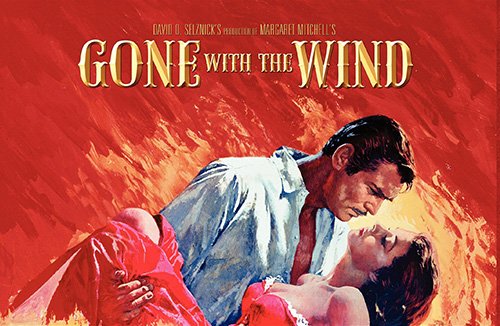Gone with the Wind | A Film of Many Firsts
75 years ago, on December 15th 1939, Gone with the Wind had its premiere in Atlanta, Georgia. The Mayor, William B. Hartsfield, declared the day a state holiday and up to 300,000 people lined the streets on that cold winter’s night to spot the stars of the film. This sprawling epic produced many ‘firsts’ in cinematic history and 75 years on, the much loved Gone with the Wind is still known to those who have managed to sit through all of it and even those who have never seen it at all.
Duration
Gone with the Wind was Margaret Mitchell’s first novel and when film producer David O. Selznick bought the screen rights for $50,000, it was the first time an author’s work had been bought for such a large amount of money. Gone with the Wind is the longest Academy Award winner for Best Picture, only two minutes shy of four hours length in duration. It is the first film to boast an Oscar winner who gave the longest performance on screen. At 2 hours and 23 minutes, Vivien Leigh’s portrayal of the film’s heroine, Scarlett O’Hara, earned her the Best Actress Oscar in 1940.
Another Oscar-related first concerns the actress Hattie McDaniel, the first African-American to be nominated for, and subsequently win, an Academy Award. McDaniel won her first and only Oscar, the Best Supporting Actress Award, for her role as Mammie. She was also the first African-American to attend the Academy Awards as a guest.
Staying with the Oscars, Gone with the Wind was the first technicolor film to win the Best Picture award. It was also the first technicolor film that cinematographer Ernest Haller worked on, and it was the one and only time Victor Fleming would win the Oscar for Best Director (in the American Film Institute’s recently released Greatest 100 American Films of All Time, Victor Fleming is the only director to have two films featured in the top ten – Gone with the Wind and The Wizard of Oz, both released in 1939).
Sombre
On a more sombre note, screenwriter Sidney Howard died in a farm accident shortly after the completion of Gone with the Wind. His Best Adapted Screenplay award marked the beginning of posthumously awarded Oscars by the Academy. It was also the first film to receive ten Academy Awards. This record stood for twenty years until Ben-Hur scooped eleven Oscars in 1959.
The most notable award it didn’t win was Best Actor for Clark Gable, who lost out to Robert Donat for his turn in Goodbye Mr. Chips. Clark Gable wasn’t put out by his loss, however; he had regarded the film as ‘a woman’s picture’, taking the job mainly for financial reasons. At the time he was undergoing a costly divorce from his second wife, Maria Langham and the role of Rhett Butler helped pay his way through the messy separation, allowing him to marry Carole Lombard.
Fred Crane, who played Stuart Tarleton, spoke the first line in the film but it was also his first ever film acting role. Gone with the Wind was also the first film to feature a score of over three hours long, which was then the longest film score ever recorded. Film composer Max Steiner was given just three months to compose the music and in order to meet the tight deadline, Steiner worked twenty hours a day, every day, taking Benzedrine pills, a type of amphetamine, to help him stay awake to complete the job.
Controversy
Gone with the Wind premiered in Atlanta. It was the first time a film premiere was held in the South, and it was also reportedly producer David O. Selznick’s first time in the Deep South. Controversy shrouded the three-day celebration when the film’s African-American actors were forbidden to attend in the same capacity as its white actors. This was due to the absurd Jim Crow laws in the Deep South at the time. The situation riled up Clark Gable to such an extent that he threatened to pull out of the event. Gable was friendly with Hattie McDaniel, and the fact that she was not allowed to walk the same red carpet or sit with the rest of the cast incensed Gable. McDaniel managed to defuse the situation by making up an excuse as why she could not attend the event and Gable eventually did go, even though he was unhappy with the segregated red carpet.
Gone with the Wind, a film favourite dripping in firsts.


